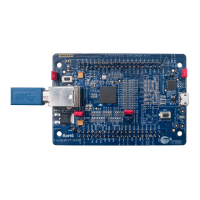EZ-USB FX3 Technical Reference Manual, Document Number: 001-76074 Rev. *F 22
Introduction to EZ-USB FX3
3. The second ACK header (3) both acknowledges receipt of the data and requests a second transaction.
4. The second data packet (4) is delivered by the device.
5. The final ACK header (5) acknowledges receipt of the data, but does not request additional data.
Figure 1-2. USB 2.0 IN Transaction Versus USB 3.0 IN Transaction
1.1.3.2.2 OUT Transaction Example
Figure 1-3 illustrates the differences between USB 2.0 and SuperSpeed OUT transactions. The example on the left shows
two back-to-back OUT transactions that require six packets:
1. Host broadcasts an OUT token packet (1) to initiate the transaction.
2. Host sends a data packet (2) to the device.
3. Device acknowledges receipt of data with an ACK handshake packet (3).
4. Steps 1-3 are repeated
The right side of Figure 1-3 shows the packet sequence required to perform two back-to-back SuperSpeed OUT transactions,
requiring only 4 packets to be exchanged:
1. SuperSpeed USB uses a data header (1) to initiate an OUT transaction and to deliver data to the device.
2. Device acknowledges receipt of data via an ACK packet (2).
3. The second data packet (3) initiates the second transaction and delivers data to the device.
4. Device acknowledges receipt of data via an ACK packet (4), completing the sequence.
Host Controller
High-Speed Device
IN Token
DATA
ACK
IN Token
ACK
DATA
Host Controller
SuperSpeed Device
ACK Header
DATA Header
+ Payload
DATA Header
+ Payload
ACK Header
ACK Header
1
4
6
5
1
3
4
2
3
2
5

